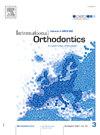评估正畸固位临床试验的结果:一项范围综述
IF 1.9
Q2 DENTISTRY, ORAL SURGERY & MEDICINE
引用次数: 0
摘要
目的评价正畸固位随机对照试验(RCTs)的结果和测量工具,并评价研究和样本特征。方法对截至2025年5月17日发表的涉及正畸固位的随机对照试验进行全面检索。将主要和次要结果分为主要领域,并记录相关的结果测量工具。获得了与样本特征、干预类型、退出率、研究设置和持续时间以及回忆间隔有关的数据。结果在1526篇文献中,共纳入129篇。牙齿排列(n = 38)和牙弓宽度变化(n = 30)分别是最常见的主要和次要结果。只有33项研究(25.6%)评估了以患者为中心的结果。结果测量的异质性在牙周和牙齿排列结果中都很明显。大多数参与者是青少年(n = 63; 48.84%),大多数纳入的研究涉及可移动固位器的不同类型之间的比较(n = 38; 29.5%)。在两个弓(n = 61, 47.3%)或单独下颌弓(n = 51, 39.5%)中考虑使用固位器的影响。平均随访时间为13.04个月,27.9%的研究报告了中等辍学率(> 10%)。结论正畸固位试验主要关注下牙弓的短期牙位排列,通常忽视了以患者为中心的结果。长期随访仍然是例外,即使在短期研究中也有中等辍学率。本文章由计算机程序翻译,如有差异,请以英文原文为准。
Outcomes assessed in clinical trials concerning orthodontic retention: A scoping review
Objectives
To assess outcomes and outcome measurement tools used in randomized controlled trials (RCTs) concerning orthodontic retention, and to evaluate the study and sample characteristics.
Methods
A comprehensive search was undertaken to identify RCTs concerning orthodontic retention in participants of any age, published up to May 17th, 2025. Primary and secondary outcomes were grouped into main domains with associated outcome measurement tool recorded. Data relating to sample characteristics, type of intervention, dropout rate, study setting and duration, and recall intervals were obtained.
Results
Of 1526 papers identified, 129 were included. Dental alignment (n = 38) and arch width changes (n = 30) were the most prevalent primary and secondary outcomes, respectively. Patient-centred outcomes were evaluated in only 33 studies (25.6%). Heterogeneity in outcome measurements was evident for both periodontal and dental alignment outcomes. Most participants were adolescents (n = 63; 48.84%) with most included studies involving comparisons between variants of removable retainers (n = 38; 29.5%). The effects of retainer use were considered in both arches (n = 61; 47.3%) or the mandibular arch alone (n = 51; 39.5%). The average follow-up was 13.04 months with moderate dropout rates (> 10%) reported in 27.9% of the studies.
Conclusions
Orthodontic retention trials primarily focused on short-term dental alignment in the lower arch and generally overlooked patient-centred outcomes. Prolonged follow-up remains the exception with moderate dropout rates typical even in short-term studies.
求助全文
通过发布文献求助,成功后即可免费获取论文全文。
去求助
来源期刊

International Orthodontics
DENTISTRY, ORAL SURGERY & MEDICINE-
CiteScore
2.50
自引率
13.30%
发文量
71
审稿时长
26 days
期刊介绍:
Une revue de référence dans le domaine de orthodontie et des disciplines frontières Your reference in dentofacial orthopedics International Orthodontics adresse aux orthodontistes, aux dentistes, aux stomatologistes, aux chirurgiens maxillo-faciaux et aux plasticiens de la face, ainsi quà leurs assistant(e)s. International Orthodontics is addressed to orthodontists, dentists, stomatologists, maxillofacial surgeons and facial plastic surgeons, as well as their assistants.
 求助内容:
求助内容: 应助结果提醒方式:
应助结果提醒方式:


